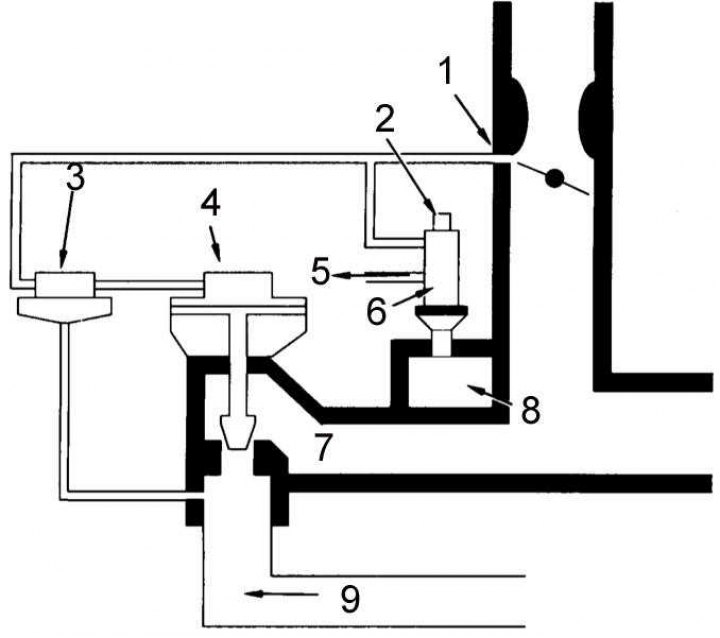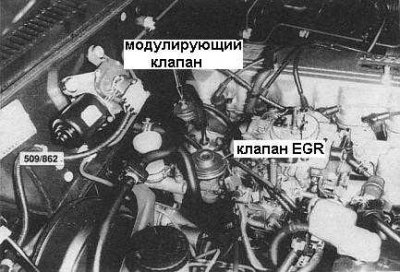Note. You will need a hand operated vacuum pump with a vacuum gauge to perform system component maintenance procedures.
Operating principle
The principle of operation of the EGR system

1 - fitting of the control vacuum; 2 - atmosphere; 3 - modulating valve; 4 - EGR control valve; 5 - to the distributor 6 - TVV; 7 - inlet pipeline; 8 - coolant; 9 - exhaust gases

In order to reduce the level of nitrogen oxides in the exhaust system, part of the exhaust gases is sent back to the engine. The main components of the recirculation system are the EGR valve, modulating valve and thermal vacuum valve (TVV) (the location of the first two on the engine is shown in the accompanying illustration).
The modulating valve controls the amount of vacuum applied to the EGR valve to maintain a constant level of EGR.
At low coolant temperatures, the TVV is closed and blocks the vacuum access to the EGR valve, keeping the latter also closed.
When the coolant temperature reaches its normal operating temperature, the TVV opens allowing vacuum to reach the modulating valve.
The modulating valve diaphragm is compressed by exhaust gases from the exhaust system and provides or shuts off the air supply to the vacuum tube of the EGR valve, thereby controlling the opening / closing of the latter.
At low loads or low engine speeds, when the exhaust gas pressure is low, the diaphragm spring overcomes this pressure, opening the air supply. Accordingly, the EGR valve remains closed.
At high loads / engine speeds, the exhaust gas pressure also rises, overcoming the resistance of the diaphragm spring and cutting off the air supply. In this case, the EGR valve is affected by the full depth of depression, which raises the level of exhaust gas recirculation.
System Function Check
1. Check the condition of all vacuum hoses. Replace defective ones.
2. Start the engine and warm it up to normal operating temperature. With the engine running, open and close the throttle, observing the behavior of the EGR diaphragm. The EGR valve should open and close at the same time as the throttle.
3. If the test conditions are not met, test the system components individually.
Checking the EGR valve
4. Shut off the engine and disconnect the vacuum line from the EGR valve.
5. Connect a hand vacuum pump with a gauge to the EGR valve and apply a vacuum of 120 mmHg. Art.
6. The valve should open smoothly and remain open until the vacuum is released, otherwise it must be replaced.
Checking the modulating valve
1. Insert a suitable length of wire into the bottom fitting of the modulating valve.
2. Slightly depress the diaphragm and use a hand vacuum pump to create a vacuum at the top valve port.
3. If the valve does not hold vacuum, it can be considered faulty.
4. Checking the thermal vacuum valve
5. Start the engine from a cold state. Disconnect the vacuum hose from the top fitting of the modulating valve.
6. Put your finger on the open end of the hose and increase engine speed. Vacuum should not be felt.
7. Warm up the engine to normal operating temperature. Re-attach your finger to the end of the hose and raise the speed. Now you should feel a vacuum.
8. Replace TVV if necessary (the location of the TVV on the engine is shown in the accompanying illustration).
Checking the thermal vacuum valve
1. Start the engine from a cold state. Disconnect the vacuum hose from the top fitting of the modulating valve.
2. Put your finger on the open end of the hose and increase the engine speed. Vacuum should not be felt.
3. Warm up the engine to normal operating temperature. Re-attach your finger to the end of the hose and raise the speed. Now you should feel a vacuum.

4. Replace TVV if necessary (the location of the TVV on the engine is shown in the accompanying illustration).